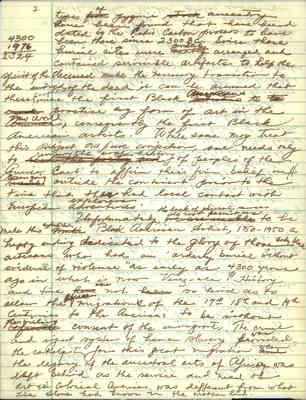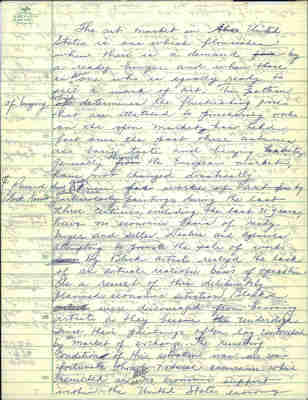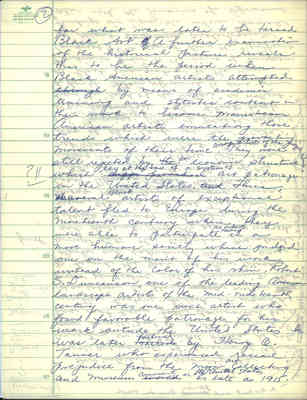Pages
1
types [crossed out: from] of pygmies [crossed out: stock] ancestry have been found that have been(?) [left margin : 4300 - 1976 = 2324] dated by the Radio Carbon process to have been there since 2300 BC. Since these burial cites were [crossed out: neatly] orderly arranged and contained servicible artifacts to help the spirit of the deceased make the necessary transition to the world of the dead it can be assumed that these [^people] were the first Black [crossed out: artisans] [crossed out : people] americans to [crossed out : to] [crossed out : work] practice any form of art in the [crossed out : americas] new world, consequently the first Black american artists. While some may treat this subject as pure conjection, one needs only to [crossed out : read the poetry and] review the oral history of peoples of the "Guinea Cost" to affirm their firm belief in [crossed out : travels] ocean going outside the continent prior to the time thet they had local contact with European adventures [written above : explorers].
Unfortunately, [crossed out : we are unable] the lack of phiscal(?) services(?) do not permit us to be make this [crossed out: make] exhibition Black American Artist, 1750 - 1950 a happy ending dedicated to the glory of those early black artisans who had an "orderly burial without evidence of violence" as early as 4300 years ago in what is now Venezuela. [crossed out: 9] History and time [crossed out : have] were not [crossed out : been] so kind as to allow the [written above : african] migrations of the 17th 18th and 19th Centuries to the americas to be without [crossed out : african] the willing consent of the immigrants. The cruel and injust system of human slavery provided [wtitten above: was] the catalyst for this great imigration [crossed over: and] when the legacy of the ancestral arts of africa was left behind as the service and need of art in colonial americas was different from what the slave had known in the mother land.
2
The art market in [overwrite : an] the United States is one which flourishes when there is a demand [crossed out : for] by a ready buyer and when there is ^some one who is equally ready to sell a work of art. This pattern [left margin: of buying,] [crossed out : of] which determines the fluctuating prices that are attached to purchasing works on the open market has held fast over the past three centuries as basic taste and buying habits, generally [crossed out: from] through the Europeon market, have not changed drastically. [left margin : [crossed out: C] Research ] shows ^that prices [over write : are] for works of art done by [left margin : Black American] artists, more particularly - paintings, during the last three centuries, including the last 30 years, have no economic basis of ready buyer and seller. Dealers and agencies attempting to promote the sale of works [crossed out : done] by Black artists realized the lack of an actual realistic basis of operation. As a result of this deliberately planned economic situation, Blacks [crossed out : artists] were discouraged from becoming artists as they become [crossed out : the] underdog since their paintings often lay untouched by [above line : the] market of exchange. The resulting condition(?) of this situation was an unfortunate though natural occurance which resulted in ^little or no economic support within the United States economy
3
[left margin: 2 in a circle] for what was later to be termed Black Art. [Crossed out: C] a further examination of the historical picture reveals this to be the period when Black American artists attempted [crossed out: through] by means of academic training and stylistic content in their mark to become mainstream american artists emulating those trends which were the prevailing movements of their time. [written above: among artists of the majority culture.They were still rejected by [crossed out: the] an economic structure [left margin: ? || ] which [crossed out: support provided] lay at the base of a system of art patronage [left margin: _] in the United States. [crossed over: and] Thus, [over write: Blac] several [written above: Black] artists of exceptional talent fled to Europe during the nineteenth century where they were able to participate [written above: as artists practicing] in a more humane society which judged one on the merit of his work instead of the color of his skin. Robert S. Duncanson, one of the leading American landscape artists of the mid - nineteenth century was one such artist who found favorable patronage for his work outside the United States. He was later [crossed out: trailed] followed by Henry O. Tanner who experienced racial prejudice from the major [written above : art] collecting and museum [crossed over : world] community [written above: in the United States] as late as 1915.
4
[Top left margin: ( Historical)?] Our interest in recording the [left margin: Distance for America] visual achievements of persons of African ancestry in the United States is only [crossed out: one] a small part of a story which [left margin : Disance of] has not been fully documented by [left margin: Dealing with slave art] written history. Indeed, it would [left margin : be] speculation to place [crossed out: upon] within [crossed out: the] proper perspective dated achievements that go beyond the year 1619 when black slaves and indentured servants were [left margin : first] brought into the Virginia mainland and declared property of new world citizens. However speculative it may seem, there is an oral tradition among [crossed out: native American and] Guinea Coast Africans that is backed with native American stories [over written :as] that their Black ancestors [above written: settled] scattered beyond the "waters of the setting sun" long before Columbus set sail for the East Indies by way of this land we now call the Americans. Tales of wealth and war [above written: that have come to us from native American populations in present day Mexico, Central and South Americans must now be looked upon us positive existance of African travels & (?) explorations in a distant and [crossed out: denial] glorious American past.]associated with black people from the "land of the waters" is without a doubt certain reference to some form of black immigration to the American continents prior to the time of Europeon Conquest. [crossed out: I] One cannot deny the significance of recent [crossed out: scientific] archeological findings in Venezuala(?) where burial cites with the remains of African





